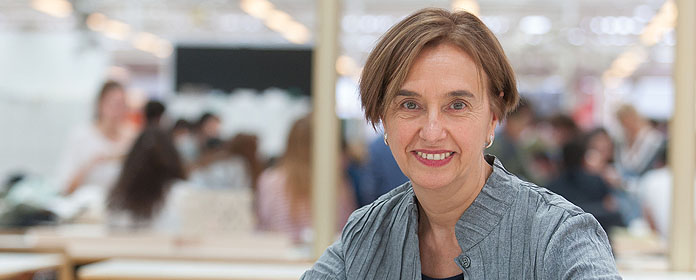2017_10_30_ARQ_maite_apezteguia
Maite Apezteguía: "In every blank piece of paper there is a project that we must be able to recognize".
The architect, in her lecture "The ridiculous idea of not recognizing you", addressed the students, bringing concepts closer to them.

The architect Maite Apezteguía gave a lecture on October 27th at the lecture at the School of Architecture University of Navarra. In her discussion paper, "The ridiculous idea of not recognizing yourself", she addressed the students by bringing concepts closer to the students.
The degree scroll of the lecture, inspired by the degree scroll of Rosa Montero's novel "La ridícula idea de no volver a verte", makes reference letter the architect's fear of blank paper. "The idea is ridiculous when we face the blank paper. In every blank paper there is a project that we must be able to recognize".
To illustrate this idea he resorted to a famous poem by Eliseo Diego:
|
I am terrified of this blank paper |
The architect showed the students different ways, all of them fundamental, when facing the projects, for this, each concept revolved around certain works projected by her.
"It is necessary to explore the place by observing the space". Apezteguía illustrated, with two examples of cemeteries, how the territory in many occasions delimits project, in others, where the topography is not so clear or does not delimit the spaces in a natural way, it is necessary to look for a coherence, that coherence is achieved by looking at the landscape.
"Observing in space, examining its content," added Maite Apezteguía. Faithful to classic and traditional concepts such as geometry or the proportionality of volumes, she showed how the architect has to face circumstances that do not favor the ideal projection on numerous occasions. An architect is faced with an urban planning that determines the place in which to place a volume, sometimes disproportionate, "the rules and regulations refuses to recognize that those who inhabit buildings have different needs".
The architect has shown exquisite sensitivity in trying to provide the best solutions, even with the wind against her back. Aware that Architecture responds to solve human problems, aware of the radical nature of humanism in this discipline, the architect encouraged the students to think about the projects "testing them in their use".
She also expressed to the students the need to project "searching in the report, evoking memories". The architect showed how she enters into dialogue with her projects, it is almost perceived that the way she faces "her white paper" is by listening to the sites and places. This is perhaps typical of a Baztanian spirit, and undoubtedly typical of a coherent professional. He also encouraged everyone to"investigate the materiality, without forgetting the poetic and inspiring part of Architecture".

